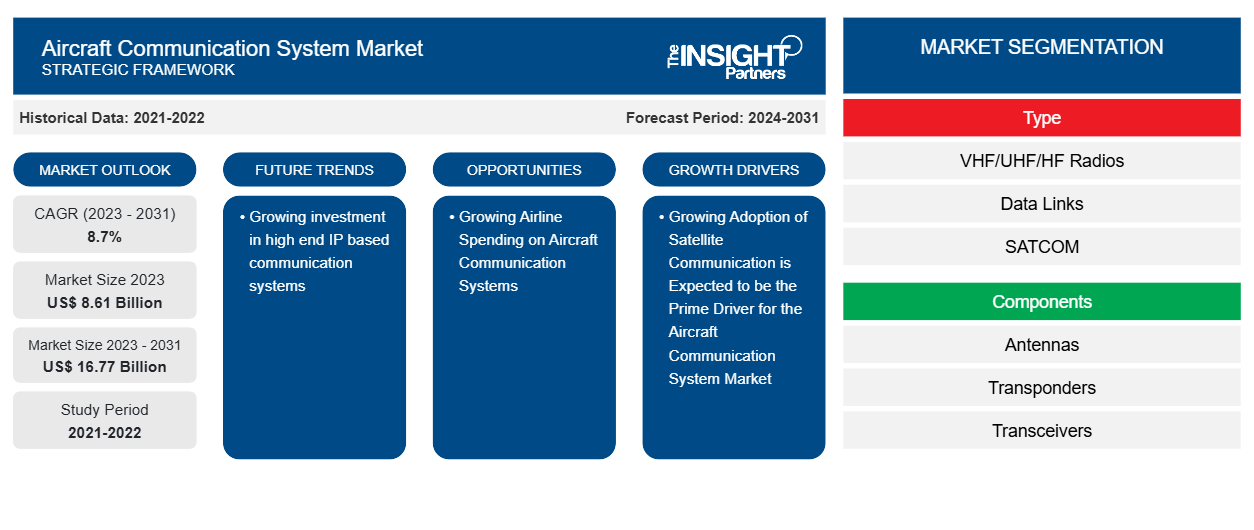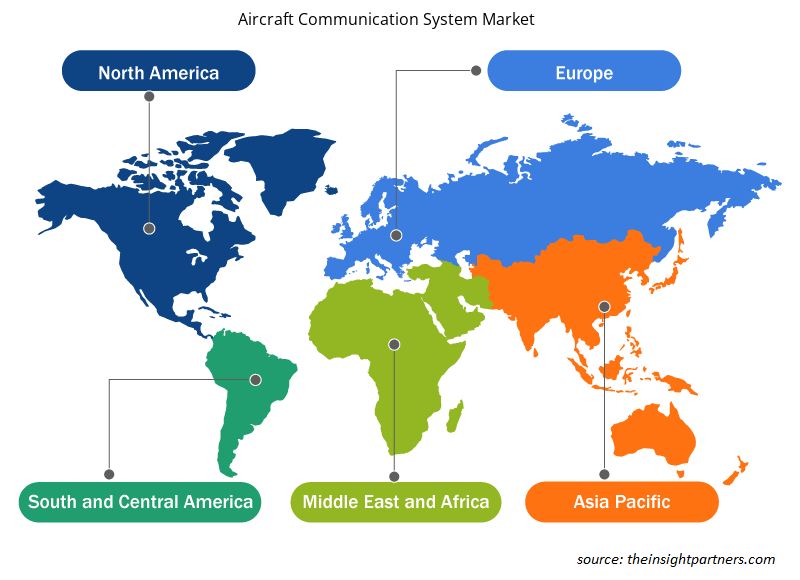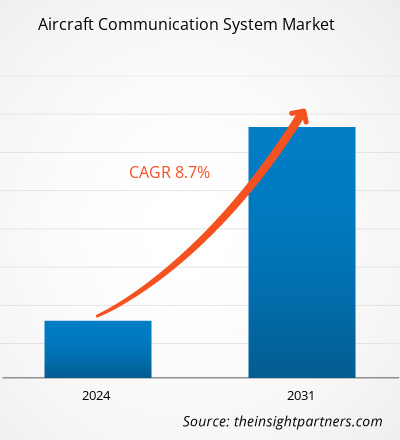The Aircraft Communication System Market size is projected to reach US$ 16.77 billion by 2031 from US$ 8.61 billion in 2023. The market is expected to register a CAGR of 8.7% in 2023–2031. The growing demand for real-time information, data exchange and connectivity are acting as a major driving factor for the aircraft communication system market globally. The increasing adoption of high-end communication systems such as SATCOM enhances the passenger experience and air traffic management which is also acting as a major driving factor for the aircraft communication system market globally.
Aircraft Communication System Market Analysis
Aircraft communication systems are primarily leveraged for data exchange, voice transmission, real-time information exchange and reception between aircraft to aircraft or ground base. The aircraft communication systems enhance the experience of satellite-based navigation surveillance which is positively impacting the growth of the aircraft communication market. Mostly, aircraft communication market vendors implement advanced technologies such as air traffic management through wireless communication technologies and high-speed connectivity trajectories. These major aircraft communication systems providers invest significantly in their research and development activities to fabricate technologically enhanced communication systems for military and commercial fleets, which is anticipated to propel the development of the aircraft communication system market over the forecast period.
Aircraft Communication System Market Overview
The technological advancement of aviation electronics, communication infrastructure, management control systems highly impacts the development of the aircraft communication market. Aircraft communication has substantially decreased the instances of airborne accidents and enhanced the communication network in times of emergency. Further, the upward trend of satellite-driven navigation systems in order to lower flight time and complexities in air traffic management is also anticipated to boost the growth of the aircraft communication system market.
Customize This Report To Suit Your Requirement
You will get customization on any report - free of charge - including parts of this report, or country-level analysis, Excel Data pack, as well as avail great offers and discounts for start-ups & universities
Aircraft Communication System Market: Strategic Insights

- Get Top Key Market Trends of this report.This FREE sample will include data analysis, ranging from market trends to estimates and forecasts.
You will get customization on any report - free of charge - including parts of this report, or country-level analysis, Excel Data pack, as well as avail great offers and discounts for start-ups & universities
Aircraft Communication System Market: Strategic Insights

- Get Top Key Market Trends of this report.This FREE sample will include data analysis, ranging from market trends to estimates and forecasts.
Aircraft Communication System Market Drivers and Opportunities
Growing Adoption of Satellite Communication is Expected to be the Prime Driver for the Aircraft Communication System Market
The growing technological advancement in the aviation industry is boosting the application of satellite-based communication infrastructure. The proliferation of software-defined radio for establishing satellite communication networks is acting as a major driver for the aircraft communication system market. The satellite communication infrastructure involves a wide array of network technologies for convenient and smooth connectivity services between fleet and ground staff. The flexibility and high-speed connectivity are driving the demand for satellite communication systems which is acting as a major driving factor for the aircraft communication system market globally.
Growing Airline Spending on Aircraft Communication Systems
The aircraft companies are focusing on integrating high-end communication systems for better operational management. The high-end aircraft communication systems help in establishing a proper connection between aircraft and ground base conveniently in time of emergency. Additionally, it also reduces the risk of aircraft casualties. Exchanging real-time data related to flight timings, position, condition, and control are major attributes of aircraft communication systems. In terms of commercial aircraft, communication between the pilot and ground staff is crucial at the time of take-off and landing. Additionally, military or defense aircraft also exchange crucial information related to missions, such as target position, fuel status, fleet location, and critical mission-driven information. The growing importance of communication networks in the aviation sector is anticipated to propel the growth of the aircraft communication system market over the forecast period.
Aircraft Communication System Market Report Segmentation Analysis
Key segments that contributed to the derivation of the aircraft communication system market analysis are type, components, and aircraft type.
- Based on the type, the aircraft communication system market has been divided into VHF/UHF/HF Radios, data links, and SATCOM. The VHF/UHF/HF Radios segment held a larger market share in 2023.
- In terms of components, the market has been segmented into antennas, transponders, transceivers, and displays & processors. The transponders segment dominated the market in 2023.
- In terms of aircraft type, the market has been segmented into commercial aircraft and military aircraft. The commercial segments dominated the market in 2023.
Aircraft Communication System Market Share Analysis by Geography
The geographic scope of the Aircraft Communication System Market report is mainly divided into five regions: North America, Europe, Asia Pacific, Middle East & Africa, and South America.
North America led the aircraft communication system market in 2023. The North America region includes the US, Canada, and Mexico. High investment in advanced technologies and wireless connectivity for the airline sector is acting as a major driver for the market. The high presence of airlines and major aircraft communication system manufacturers is also driving the growth of the aircraft communication system market in North America. Increasing research and development activities in the aviation sector for enhancing the features of commercial and defense aircraft for more enhanced communication infrastructure is driving the growth of the aircraft commercial system market in North America.
Aircraft Communication System Market Regional Insights
The regional trends and factors influencing the Aircraft Communication System Market throughout the forecast period have been thoroughly explained by the analysts at The Insight Partners. This section also discusses Aircraft Communication System Market segments and geography across North America, Europe, Asia Pacific, Middle East and Africa, and South and Central America.

- Get the Regional Specific Data for Aircraft Communication System Market
Aircraft Communication System Market Report Scope
| Report Attribute | Details |
|---|---|
| Market size in 2023 | US$ 8.61 Billion |
| Market Size by 2031 | US$ 16.77 Billion |
| Global CAGR (2023 - 2031) | 8.7% |
| Historical Data | 2021-2022 |
| Forecast period | 2024-2031 |
| Segments Covered |
By Type
|
| Regions and Countries Covered | North America
|
| Market leaders and key company profiles |
Aircraft Communication System Market Players Density: Understanding Its Impact on Business Dynamics
The Aircraft Communication System Market is growing rapidly, driven by increasing end-user demand due to factors such as evolving consumer preferences, technological advancements, and greater awareness of the product's benefits. As demand rises, businesses are expanding their offerings, innovating to meet consumer needs, and capitalizing on emerging trends, which further fuels market growth.
Market players density refers to the distribution of firms or companies operating within a particular market or industry. It indicates how many competitors (market players) are present in a given market space relative to its size or total market value.
Major Companies operating in the Aircraft Communication System Market are:
- Honeywell International Inc
- Northrop Grumman Corporation
- General Dynamic Corporation
- L3Harris Technologies Inc
- Cobham Plc
- Thales Group
Disclaimer: The companies listed above are not ranked in any particular order.

- Get the Aircraft Communication System Market top key players overview
Aircraft Communication System Market News and Recent Developments
The Aircraft Communication System Market is evaluated by gathering qualitative and quantitative data post primary and secondary research, which includes important corporate publications, association data, and databases. The following is a list of developments in the market for aircraft communication systems market and strategies:
- On August 2023, Northrop Grumman Corporation, in collaboration with the U.S. Air Force, completed an integrated airborne mission transfer (IAMT) demonstration with the B-2 Spirit at Whiteman Air Force Base. (Source: Northrop Grumman Corporation, Press Release/Company Website/Newsletter)
- On April 2024, Thales Group acquired Cobham Aerospace Communications to strengthen its foothold in safety cockpit communications. (Source: Thales Group, Press Release/Company Website/Newsletter)
Aircraft Communication System Market Report Coverage and Deliverables
The “Aircraft Communication System Market Size and Forecast (2021–2031)” report provides a detailed analysis of the market covering below areas:
- Market size and forecast at global, regional, and country levels for all the key market segments covered under the scope
- Market dynamics such as drivers, restraints, and key opportunities
- Key future trends
- Detailed PEST analysis
- Global and regional market analysis covering key market trends, major players, regulations, and recent market developments
- Industry landscape and competition analysis covering market concentration, heat map analysis, prominent players, and recent developments
- Detailed company profiles with SWOT analysis
- Historical Analysis (2 Years), Base Year, Forecast (7 Years) with CAGR
- PEST and SWOT Analysis
- Market Size Value / Volume - Global, Regional, Country
- Industry and Competitive Landscape
- Excel Dataset
- Aircraft MRO Market
- Helicopter Hoists Winches and Hooks Market
- Fixed-Base Operator Market
- Aerospace Fasteners Market
- Aerospace Stainless Steel And Superalloy Fasteners Market
- Aircraft Floor Panel Market
- Military Optronics Surveillance and Sighting Systems Market
- Smoke Grenade Market
- Airport Runway FOD Detection Systems Market
- Artillery Systems Market
Testimonials
Reason to Buy
- Informed Decision-Making
- Understanding Market Dynamics
- Competitive Analysis
- Identifying Emerging Markets
- Customer Insights
- Market Forecasts
- Risk Mitigation
- Boosting Operational Efficiency
- Strategic Planning
- Investment Justification
- Tracking Industry Innovations
- Aligning with Regulatory Trends
Yes! We provide a free sample of the report, which includes Report Scope (Table of Contents), report structure, and selected insights to help you assess the value of the full report. Please click on the "Download Sample" button or contact us to receive your copy.
Absolutely — analyst assistance is part of the package. You can connect with our analyst post-purchase to clarify report insights, methodology or discuss how the findings apply to your business needs.
Once your order is successfully placed, you will receive a confirmation email along with your invoice.
• For published reports: You’ll receive access to the report within 4–6 working hours via a secured email sent to your email.
• For upcoming reports: Your order will be recorded as a pre-booking. Our team will share the estimated release date and keep you informed of any updates. As soon as the report is published, it will be delivered to your registered email.
We offer customization options to align the report with your specific objectives. Whether you need deeper insights into a particular region, industry segment, competitor analysis, or data cut, our research team can tailor the report accordingly. Please share your requirements with us, and we’ll be happy to provide a customized proposal or scope.
The report is available in either PDF format or as an Excel dataset, depending on the license you choose.
The PDF version provides the full analysis and visuals in a ready-to-read format. The Excel dataset includes all underlying data tables for easy manipulation and further analysis.
Please review the license options at checkout or contact us to confirm which formats are included with your purchase.
Our payment process is fully secure and PCI-DSS compliant.
We use trusted and encrypted payment gateways to ensure that all transactions are protected with industry-standard SSL encryption. Your payment details are never stored on our servers and are handled securely by certified third-party processors.
You can make your purchase with confidence, knowing your personal and financial information is safe with us.
Yes, we do offer special pricing for bulk purchases.
If you're interested in purchasing multiple reports, we’re happy to provide a customized bundle offer or volume-based discount tailored to your needs. Please contact our sales team with the list of reports you’re considering, and we’ll share a personalized quote.
Yes, absolutely.
Our team is available to help you make an informed decision. Whether you have questions about the report’s scope, methodology, customization options, or which license suits you best, we’re here to assist. Please reach out to us at sales@theinsightpartners.com, and one of our representatives will get in touch promptly.
Yes, a billing invoice will be automatically generated and sent to your registered email upon successful completion of your purchase.
If you need the invoice in a specific format or require additional details (such as company name, GST, or VAT information), feel free to contact us, and we’ll be happy to assist.
Yes, certainly.
If you encounter any difficulties accessing or receiving your report, our support team is ready to assist you. Simply reach out to us via email or live chat with your order information, and we’ll ensure the issue is resolved quickly so you can access your report without interruption.





















 Get Free Sample For
Get Free Sample For